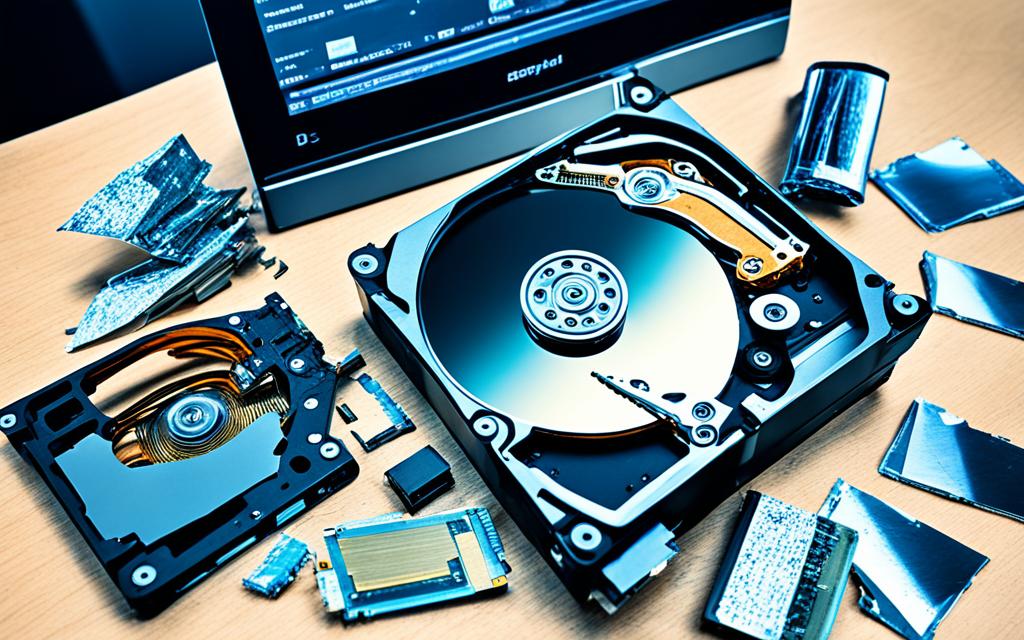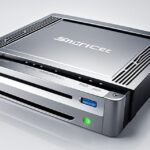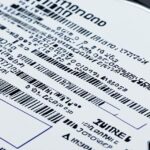Table of Contents
HDDs can fail, leading to lost data. This is a big concern for anyone storing important files digitally. Recovering data from a damaged drive is possible, particularly with logical damage. Logical damage means the data’s structure is broken, not the drive itself. Research shows a lot of HDD failures are due to logical issues caused by errors or malware1. This guide will help you understand how to get back your vital personal or work data from a failed HDD.
Key Takeaways
- Recovering data from a damaged HDD can differ greatly, depending on the damage type.
- Logical damage makes up a large part of cases where recovery is possible.
- Using special data recovery software helps a lot with logical damage.
- If the damage is physical, you might need expert help to get your data back.
- Making a full copy of your data as a backup is crucial to prevent data loss.
- Regular backups reduce the worry of losing data if your HDD fails.
- Keeping an eye on your HDD’s health can spot problems early, before they get worse.
Understanding Hard Drive Damage
It’s vital to understand hard drive damage for successful data rescue. There are two major damage types: logical damage and physical damage. Grasping this helps in taking the right action to get lost data back.
Types of Hard Drive Damage
Logical damage often comes from corrupted file systems. This can happen through viruses, incorrect shutdowns, or wrong partitioning. Physical damage means actual harm to the drive’s parts. This might be due to too much heat, power issues, or a shock2. The way to recover data changes with the type of damage.
Common Symptoms of Failure
Knowing the signs of a failing hard drive is key for quick help. Physical damage shows as weird noises, too much heat, or many error alerts. Logical damage signs are vanishing files, system crashes, and boot-up issues3. If you see these signs, stop using the drive. This stops further loss. Then, think about using data recovery software or getting professional help.
| Type of Damage | Common Causes | Typical Symptoms | Recommended Recovery Approach |
|---|---|---|---|
| Logical Damage | File system corruption, malware, accidental formatting | Disappearing files, system crashes, boot issues | Data recovery software like Disk Drill or contact help |
| Physical Damage | Overheating, power surges, physical shock | Strange noises, overheating, inability to boot | Seek professional data recovery services |
Knowing both damage types helps in making smart choices for recovery4.
Recognising Logical vs. Physical Damage
It’s key to tell logical and physical hard drive damage apart. Each has unique signs and ways to fix them. This helps you choose how to get your data back.
What is Logical Damage?
Logical damage happens when data gets lost or corrupted due to software mishaps or human slip-ups. It’s often because of accidental deletion, formatting errors, or file system problems5. Such mistakes are pretty common, making data hard to get to6. Thankfully, if you have the right tools, you can often fix logical damage yourself at home6. Keeping regular backups of your data reduces the chance of losing it.
What is Physical Damage?
Physical damage, on the other hand, affects the storage device’s actual parts. It may come from a broken part, the environment, or accidents like drops or water damage5. When hardware is damaged, you usually can’t get to your files without help from pros with special tools5. While not as common as logical errors, physical issues mean the BIOS can’t see the drive, showing a big problem6. Trying to fix physical damage by yourself can make things worse and lead to more damage6.
How to Recover Data from Damaged HDD
If you’re dealing with a damaged hard drive, knowing how to start the recovery matters a lot. Getting familiar with data recovery steps plays a big part in how well the recovery goes. First, figure out how bad the damage is before trying to fix it.
Step-by-Step Recovery Process
Begin by making a full backup of the drive. This keeps the original data safe from any more harm. After backing up, look for ways to recover deleted files and get your important data back. Sometimes, simple solutions like checking the Recycle Bin or using backups you already have can work well for logical damage. If the problem is physical, you’ll need special tools.
Using Data Recovery Software
Using software recovery tools is a great way to get your data back. Programs like EaseUS Data Recovery Wizard are very effective, with a 99.7% success rate. They’re also well-trusted, holding a Trustpilot score of 4.7 since 20057. Other software, like “Recover My Files” by GetData, is great for fixing corrupted files and also has a good success rate8. There are many tools available for different recovery needs, giving people with damaged drives lots of options.
When to Seek Professional Help for Data Recovery
Sometimes, trying to recover data by yourself can be risky and may cause more problems. It’s important to notice when you might need help from a professional data recovery service to protect your important data.
Signs That Professional Recovery is Needed
There are signs that may show your hard drive needs expert help. Keep an eye out for:
- Persistent clicking sounds: This usually means there’s an internal mechanical problem.
- A burning smell: This might show there’s overheating or electrical damage.
- Inaccessibility: If you can’t get into your drive after trying many times, it’s probably time to call a pro.
Experts advise against using recovery software to avoid making things worse9. If you notice these signs, it might be time to contact a service. They use special tools in a super clean room to fix serious physical damage10.
Choosing a Data Recovery Service
Consider several points when picking a recovery service:
- Reputation: Seek out services with great reviews from past customers.
- Success Rate: Look into how many successful recoveries the service has made to judge their skill.
- Technological Expertise: Find out what technology they use, especially important for fixing physical damage9.
If you’re dealing with physical damage, choosing professional data recovery is often the best route, said many users10. By picking a service with good reviews and knowledge, you’ll boost your chances of getting your data back successfully.
Preventing Data Loss and Drive Damage
Keeping information safe and hard drives lasting longer needs careful planning. To stop data loss, it’s crucial to set up strong protection steps. These steps shield against possible dangers.
Importance of Regular Backups
Regular backups are key for keeping data safe. They help avoid the loss of important files if something unexpected happens, like a hardware crash or if files get deleted by mistake. Making backups often ensures that critical data is safe. It also means you’re not just relying on one hard drive.
Professional data recovery can cost a lot, between $300 and $850. So, having a good backup system is a smart choice. It saves money in the long run11.
Monitoring Hard Drive Health with SMART Data
Using SMART to monitor hard drives is really helpful. SMART stands for Self-Monitoring, Analysis, and Reporting Technology. It can spot issues early, before they turn into big problems.
Programs like CrystalDiskInfo let users keep an eye on their drives. They look at important signs that show if the drive might fail soon. Combining SMART with regular backups can prevent losing data. It also helps drives last longer. It’s important to check drives and backups often to stop problems before they start12.
Conclusion
Recovering data from a damaged HDD is more than a tech issue; it’s about resilience and know-how. To succeed, it’s crucial to know what harm your hard drive faces, like mechanical or logical faults. Spotting these issues early boosts your chances of getting your data back. Use advanced tools like WinfrGUI, or get help from experts13.
HDDs often recover data better than SSDs in many situations. This fact should guide you, especially when dealing with system crashes or accidental deletes14. Our advice? Look after your hard drive with regular upkeep and backups. This protects your precious data from being lost unexpectedly.
Being proactive is key in data recovery. Follow the advice shared, and stay aware of threats posed by human mistakes and the environment. Make saving your data a top priority, not something you think about last. This way, you’re better shielded against losing data in the future15.
FAQ
What should I do if my hard drive makes strange noises?
If you hear clicking or grinding from your hard drive, it’s a bad sign. Stop using it right away to avoid more data loss. You should think about getting help from experts who can recover your data.
Can data be recovered from a formatted hard drive?
Yes, you can often get data back from a drive that’s been formatted. This can work well if the problem is with how the data is structured rather than with the data itself. Using programs like Disk Drill can help you find files that haven’t been overwritten yet.
How often should I back up my data to prevent loss?
Backing up your important files weekly is a good idea. Using online storage and an external drive gives you two safe places for your data.
What is SMART data, and why is it important?
SMART stands for Self-Monitoring, Analysis, and Reporting Technology. It tells you how your hard drive is doing. Keeping an eye on SMART data lets you spot problems early, possibly avoiding a big disaster.
How do I know if I need professional data recovery services?
You might need an expert if your drive makes strange sounds, looks damaged, or won’t respond at all. These experts have the right tools and knowledge to recover data without causing more harm.
Are there risks associated with DIY data recovery attempts?
Trying to recover your own data can be risky. Without the right skills and tools, you could lose your data forever or damage your drive more. If you’re not sure what to do, it’s safer to talk to a professional.
What types of data recovery software are recommended?
Programs like Disk Drill, Recuva, and EaseUS Data Recovery Wizard are great for getting back lost files. They work well for fixing hard drives that are damaged or corrupted.
Source Links
- https://techcommunity.microsoft.com/t5/windows-11/how-to-recover-data-from-a-corrupted-hard-drive-on-windows-11/td-p/4091084 – How to recover data from a corrupted hard drive on Windows 11
- https://www.cleverfiles.com/howto/crashed-hard-drive-recovery.html – How to Recover Data from a Corrupted or Crashed Hard Drive (2024)
- https://recoverit.wondershare.com/harddrive-recovery/dead-hard-drive-recovery.html – How To Recover Data From a Dead/Damaged Hard Drive
- https://recoverit.wondershare.com/free-data-recovery/damaged-hard-drive-recovery-software.html – Top 10 Damaged Hard Drive Recovery Software Free[2024]
- https://www.pitsdatarecovery.com/blog/physical-data-loss-and-logical-data-loss/ – Physical Data Loss and Logical Data Loss
- https://www.datarecoveryspecialists.co.uk/blog/physical-vs-logical-data-recovery – Data Recovery Specialists
- https://www.easeus.com/data-recovery/recover-data-from-dead-hard-drive.html – How to Recover Data from Damaged Hard Drive | with Tips
- http://www.geekyprojects.com/storage/how-to-recover-data-from-a-broken-hard-drive/ – How to Recover Data From a Broken Hard Drive
- https://www.flashbackdata.com/how-hard-drive-recovery-works/ – How Does Hard Drive Data Recovery Work
- https://community.spiceworks.com/t/damaged-hdd-data-recovery/441935 – Damaged HDD Data Recovery
- https://superuser.com/questions/1765126/hard-disk-failed-no-backup-how-to-proceed-with-data-recovery – Hard disk failed, no backup – how to proceed with data recovery?
- https://community.spiceworks.com/t/how-to-prevent-hard-drive-failure/378085 – How to prevent hard drive failure
- https://www.winfr.org/docs/recover-hard-drive-files/recover-data-from-damaged-hard-drive.html – How to Recover Data from Damaged Hard Drive
- https://www.tcdi.com/5-factors-to-consider-when-attempting-to-recover-deleted-data-from-hard-drives/ – 5 Factors to Consider When Attempting to Recover Deleted Data from Hard Drives
- https://www.downtowncomputers.com/data-recovery-101-comprehensive-look-restoring-files-from-failed-hard-drive/ – Essential Steps for Data Recovery from a Failed Hard Drive












